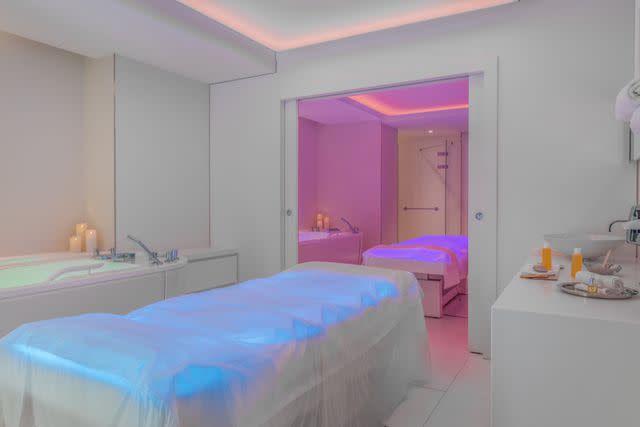I Tried Fascia Therapy to Finally Loosen Up—Here's How It Went
Plus, everything you need to know.

Getty Images
This November, I found myself at a spa in Monaco, being told forcefully by a man with a French accent that I must relax. I was at the Thermes Marins spa, which is connected to the castle-like Hôtel Hermitage (who invited me to the tiny country) and had just spent a day swimming in the gorgeous indoor pool and getting luxurious spa treatments like a full-body massage and cryotherapy. But now, I was in for something I had never tried before a fascia therapy treatment.
The treatment, which targets the connective membrane under your skin, is nothing like any spa treatment I’ve ever experienced. And, though it was certainly unique, it did—spoiler alert—leave me much more relaxed (though my stay at one of Monte Carlo's prettiest hotels didn't hurt). Ahead is everything you need to know about the treatment, plus my honest review.

Thermes Marines
What Is Fascia Therapy?
First things first, what exactly is fascia? "Fascia is a connective tissue found throughout the body, surrounding muscles, organs, and other structures," says Patrick Provost, the fascia therapist at Thermes Marins. "It plays a role in providing support, protection, and facilitating movement." Think of fascia like a web—it's strong but flexible and spans your whole body. Just like your muscles themselves, fascia can get tight and limit your muscle and joint movements.
Fascia therapy manages this tightness. "Fascia therapy, also known as myofascial release or fascial manipulation, aims to address restrictions or tension in the fascia," says Provost. "Benefits can include improved flexibility, reduced pain, enhanced posture, and better overall movement efficiency."
What to Expect During Fascia Therapy
Though I got the treatment at the spa, it's much more akin to physical therapy than a traditional spa treatment. I remained fully clothed—I wore loose jeans and a tank top, but athleisure would have been a better choice—and while it feels sort of like a massage (more on that in a second), there are no lotions or oils, as your therapist needs to feel any knots in your fascia.
"Someone new to fascia therapy can expect a session involving various techniques such as gentle stretching, manual manipulation, or the use of specialized tools," says Provost. "The therapist may target specific areas of tension or restriction based on the individual's needs." For me, that was a focus on the head, neck, and shoulders—Provost was shocked by how much tension I carried in these areas (hence his instructions to calm down).
As for the actual treatment, it felt almost like a massage. Essentially, your therapist gently massages the areas of concern. Since they are targeting the fascia around the muscle, not the muscles themselves, the pressure is very light and feels surface-level—almost like they are just moving your skin around. It's very pleasant—I particularly liked it when my fascia therapist worked on my neck and face—and it didn't hurt. But it did leave me craving a deep-tissue massage.

Thermes Marins
How Often to Get Fascia Therapy
"The frequency of fascia therapy sessions can vary depending on factors such as the severity of the issues being addressed and individual response to treatment," says Provost. "Initially, sessions may be more frequent (e.g., weekly), with spacing out as improvements are made. Ultimately, it's best to follow the recommendations of a qualified therapist."
There are also a few ways to keep the benefits going when you get home. Provost recommends regular stretching and mobility exercises and "self-myofascial release techniques using foam rollers, massage balls, or other tools." He also suggests maintaining good posture and staying hydrated, and, as he told me many times, keeping stress to a minimum.
My Review
I went into this treatment totally blind, but I left pleasantly surprised. Aside from stress-related shoulder tension, I'm generally not prone to muscle pain (not a brag; I just hate exercising), so I probably wasn't the ideal candidate, but I still enjoyed this treatment. As mentioned, it's very enjoyable, and despite happening in a more sterile-feeling room, it still felt very relaxing.
I did feel relaxed, and my body felt less stiff after the treatment, so I do think it did something. If you're struggling with chronic pain, fascia therapy is worth checking out. That being said, if I was in the mood for some pampering, I would opt for one of the spa's more traditional treatments, like a deep tissue massage or La Prairie facial.
Read the original article on Byrdie.

